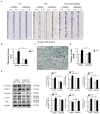Follistatin Is a Novel Chemoattractant for Migration and Invasion of Placental Trophoblasts of Mice
- PMID: 36497076
- PMCID: PMC9741044
- DOI: 10.3390/cells11233816
Follistatin Is a Novel Chemoattractant for Migration and Invasion of Placental Trophoblasts of Mice
Abstract
Follistatin (FST) as a gonadal protein is central to the establishment and maintenance of pregnancy. Trophoblasts' migration and invasion into the endometrium are critical events in placental development. This study aimed to elucidate the role of FST in the migration and invasion of placental trophoblasts of mice. We found that FST increased the vitality and proliferation of primary cultured trophoblasts of embryonic day 8.5 (E8.5) mice and promoted wound healing of trophoblasts. Moreover, FST significantly induced migration of trophoblasts in a microfluidic device and increased the number of invasive trophoblasts by Matrigel-coated transwell invasion assay. Being treated with FST, the adhesion of trophoblasts was inhibited, but intracellular calcium flux of trophoblasts was increased. Western blotting results showed that FST had no significant effects on the level of p-Smad3 or the ratio of p-Smad3/Smad3 in trophoblasts. Interestingly, FST elevated the level of p-JNK; the ratio of p-JNK/JNK; and expression of migration-related proteins N-cadherin, vimentin, ezrin and MMP2 in trophoblasts. Additionally, the migration of trophoblasts and expression of N-cadherin, vimentin, and MMP2 in trophoblasts induced by FST were attenuated by JNK inhibitor AS601245. These findings suggest that the elevated FST in pregnancy may act as a chemokine to induce trophoblast migration and invasion through the enhanced JNK signaling to maintain trophoblast function and promote placental development.
Keywords: JNK signaling; follistatin; migration; trophoblasts.
Conflict of interest statement
The authors declare no conflict of interest.
Figures








Similar articles
-
Follistatin dysregulation impaired trophoblast biological functions by GDF11-Smad2/3 axis in preeclampsia placentas.Placenta. 2022 Apr;121:145-154. doi: 10.1016/j.placenta.2022.03.015. Epub 2022 Mar 22. Placenta. 2022. PMID: 35339026
-
Follistatin is a crucial chemoattractant for mouse decidualized endometrial stromal cell migration by JNK signalling.J Cell Mol Med. 2023 Jan;27(1):127-140. doi: 10.1111/jcmm.17648. Epub 2022 Dec 18. J Cell Mol Med. 2023. PMID: 36528873 Free PMC article.
-
Expression of N-Acetylglucosaminyltransferase III Promotes Trophoblast Invasion and Migration in Early Human Placenta.Reprod Sci. 2019 Oct;26(10):1373-1381. doi: 10.1177/1933719118765967. Epub 2018 Apr 11. Reprod Sci. 2019. PMID: 29642803
-
The function of miR-519d in cell migration, invasion, and proliferation suggests a role in early placentation.Placenta. 2016 Dec;48:34-37. doi: 10.1016/j.placenta.2016.10.004. Epub 2016 Oct 10. Placenta. 2016. PMID: 27871470 Free PMC article. Review.
-
The Reign of Follistatin in Tumors and Their Microenvironment: Implications for Drug Resistance.Biology (Basel). 2024 Feb 19;13(2):130. doi: 10.3390/biology13020130. Biology (Basel). 2024. PMID: 38392348 Free PMC article. Review.
Cited by
-
Ezrin expression in female reproductive tissues: A review of regulation and pathophysiological implications.Front Cell Dev Biol. 2023 Mar 8;11:1125881. doi: 10.3389/fcell.2023.1125881. eCollection 2023. Front Cell Dev Biol. 2023. PMID: 36968198 Free PMC article. Review.
-
Activin A induces apoptosis of human lung adenocarcinoma A549 cells through endoplasmic reticulum stress pathway.Oncol Rep. 2024 Feb;51(2):29. doi: 10.3892/or.2023.8688. Epub 2023 Dec 22. Oncol Rep. 2024. PMID: 38131250 Free PMC article.
-
Revolutionizing the female reproductive system research using microfluidic chip platform.J Nanobiotechnology. 2023 Dec 19;21(1):490. doi: 10.1186/s12951-023-02258-7. J Nanobiotechnology. 2023. PMID: 38111049 Free PMC article. Review.
-
Microfluidic chips in female reproduction: a systematic review of status, advances, and challenges.Theranostics. 2024 Jul 15;14(11):4352-4374. doi: 10.7150/thno.97301. eCollection 2024. Theranostics. 2024. PMID: 39113805 Free PMC article.
-
Low follistatin level is a causal risk factor for spontaneous abortion: a two-sample mendelian randomization study.Front Endocrinol (Lausanne). 2024 Jan 3;14:1255591. doi: 10.3389/fendo.2023.1255591. eCollection 2023. Front Endocrinol (Lausanne). 2024. PMID: 38234423 Free PMC article.
References
-
- Hardy J.T., Buhimschi I.A., McCarthy M.E., Zhao G., Laky C.A., Shook L.L., Buhimschi C.S. Imbalance of Amniotic Fluid Activin-A and Follistatin in Intraamniotic Infection, Inflammation, and Preterm Birth. J. Clin. Endocrinol. Metab. 2016;101:2785–2793. doi: 10.1210/jc.2015-4147. - DOI - PMC - PubMed
MeSH terms
Substances
Grants and funding
LinkOut - more resources
Full Text Sources
Research Materials
Miscellaneous

